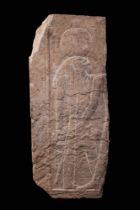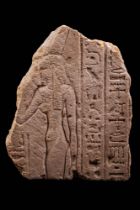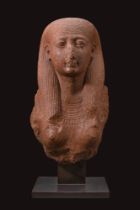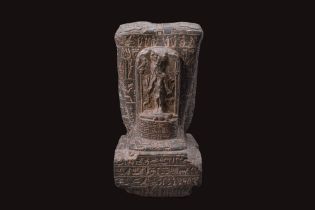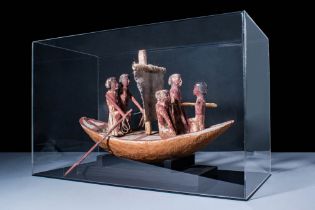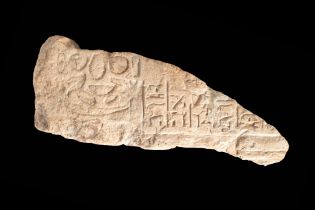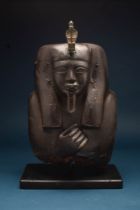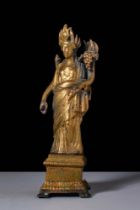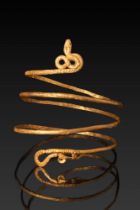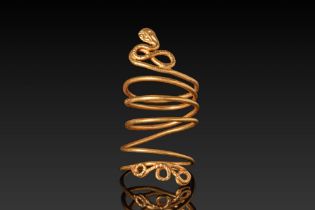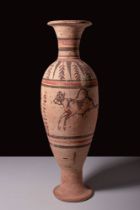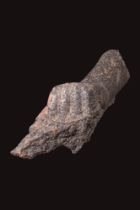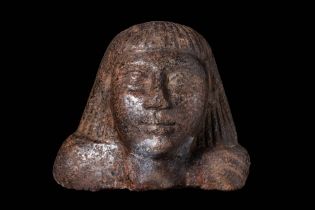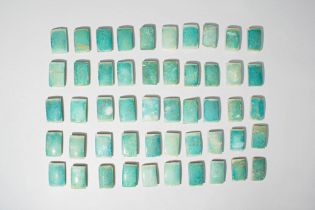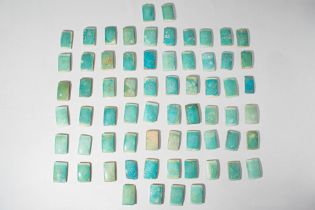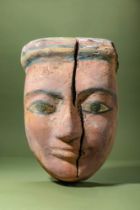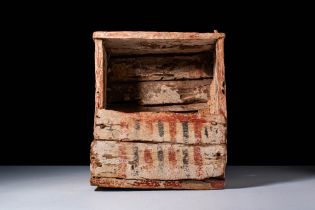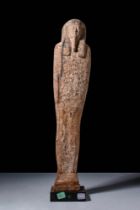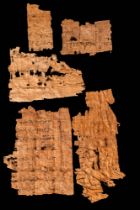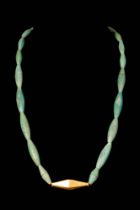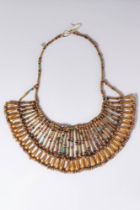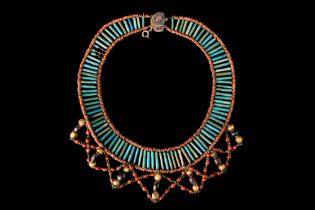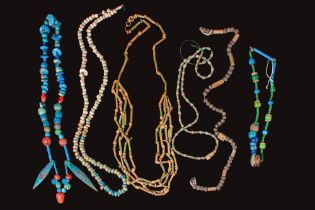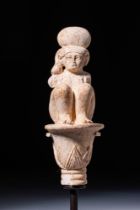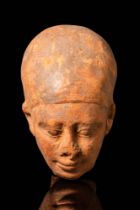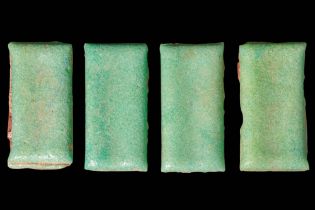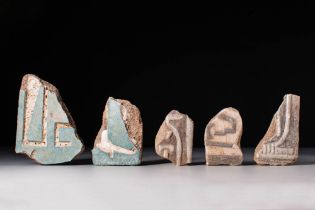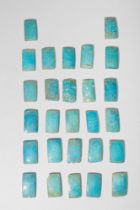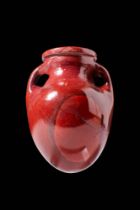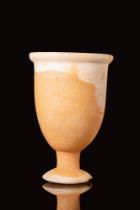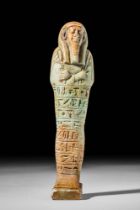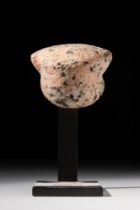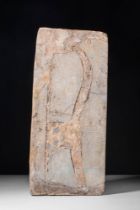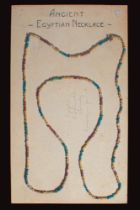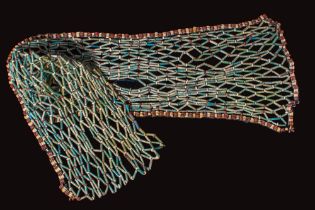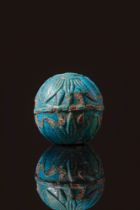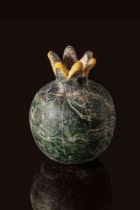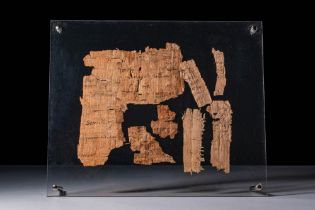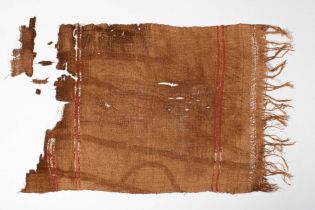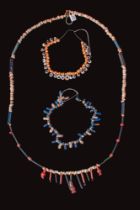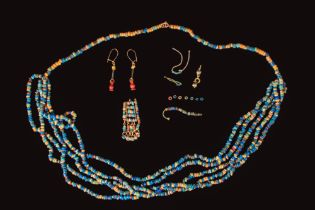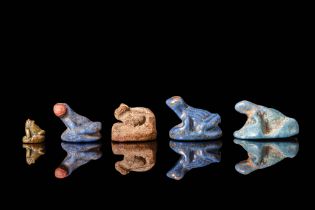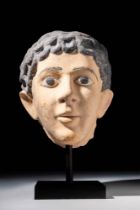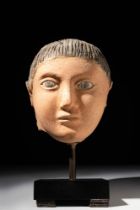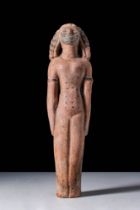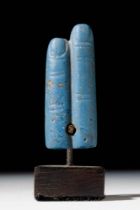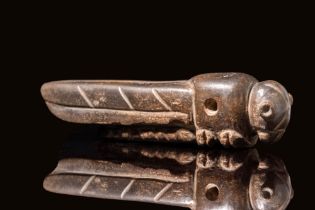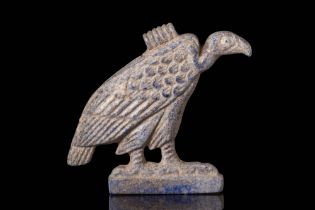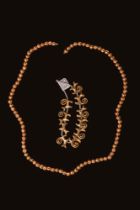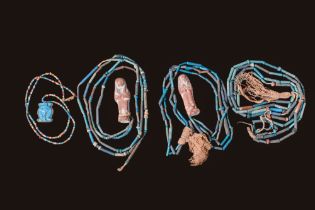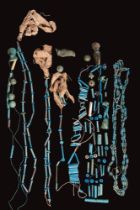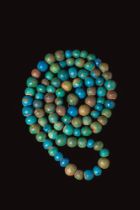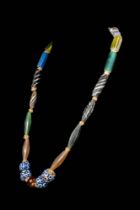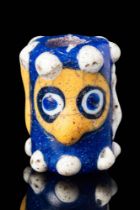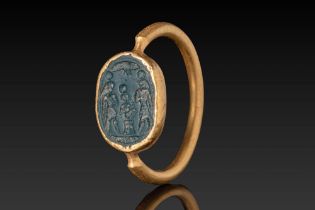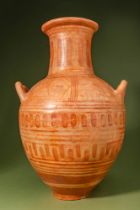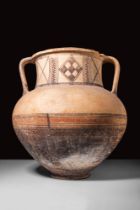Refine your search
Sale Section
- Achaemenid (1)
- African Art (1)
- Amlash (1)
- Anatolian (1)
- Anglo-Saxon (2)
- Assyro-babylonian (1)
- Bactrian (2)
- Bronze Age (5)
- Byzantine (33)
- Canaanite (1)
- Canosan (1)
- Celtic (1)
- Crusaders (1)
- Cypriot (5)
- Daunian (4)
- Egyptian (149)
- Etruscan (4)
- Gandharan (4)
- Graeco-Roman (1)
- Greek (48)
- Hellenistic (13)
- Inuit (1)
- Iron Age (2)
- Medieval (25)
- Merovingian (4)
- Mesopotamian (5)
- Minerals (5)
- Minoan (1)
- Moche (1)
- Mughal (1)
- Neo-assyrian (4)
- Neoclassical (1)
- Palmyrian (1)
- Phoenician (8)
- Post-medieval (1)
- Renaissance (2)
- Roman (92)
- Romano-Egyptian (10)
- Sasanian (5)
- Scythian (4)
- Stamp seals (6)
- Syro-Hittite (1)
- Umayyad (3)
- Viking (12)
- Western Asiatic (7)
- 中文 (1)
Estimate
Category
- Jewellery (156)
- Taxidermy & Natural History (86)
- Greek, Roman, Egyptian & other antiquities (64)
- Glassware (30)
- Sculpture (25)
- Collectables (22)
- Arms, Armour & Militaria (19)
- Clocks (16)
- Coins (12)
- Metalware (9)
- Books, Manuscripts & Periodicals (8)
- Ceramics (8)
- Salvage & Architectural Antiques (8)
- Textiles (6)
- Toys, Models & Dolls (5)
- Chinese Works of Art (4)
- Porcelain (4)
- Vintage Fashion (3)
- Scientific Instruments (2)
- Silver & Silver-plated items (2)
- Tools (2)
- Barometers (1)
- Ethnographica & tribal art (1)
- Islamic Works of Art (1)
- Kitchenalia (1)
- Oil, Acrylic paintings & Mixed Media (1)
- Sporting Memorabilia & Equipment (1)
Creator / Brand
Item Type
- Ring (106)
- Necklaces, Pendants & Medallions (65)
- Pendant (59)
- Gold Ring (31)
- Gemstone (30)
- Necklace (30)
- Intaglio (28)
- Beads (27)
- Amulet (24)
- Silver Ring (24)
- Gold Pendant (18)
- Band (17)
- Turquoise (11)
- Bowl (10)
- Earrings (10)
- Garnet (10)
- Knives and Blades (10)
- Sword (9)
- Armour (7)
- Letter (7)
- Bottle (6)
- Bust (6)
- Mineral (6)
- Bear (5)
- Bear Taxidermy (5)
- Flask (5)
- Glasses (5)
- Krater (5)
- Minerals (5)
- Sculpture (5)
- Taxidermy (5)
- Brooch (4)
- Brooches (4)
- European Coin (4)
- Medallion (4)
- Militaria (4)
- Scarab (4)
- Signet Ring (4)
- Vase (4)
- Amethyst (3)
- Bracelet (3)
- Coin (3)
- Cuff (3)
- Emerald (3)
- Figurine (3)
- Glass Bottle (3)
- Intaglio Ring (3)
- Jug (3)
- Plate (3)
- Posy Ring (3)
- Skyphos (3)
- Ushabti (3)
- Cameo (2)
- Chain (2)
- Column (2)
- Cup (2)
- Diamond (2)
- Glass Bowl (2)
- Jar (2)
- Jasper (2)
- Lighter (2)
- Military Tunic (2)
- Military Uniform (2)
- Round (2)
- Statuette (2)
- Tunic (2)
- Vessel (2)
- Amphora (1)
- Arch (1)
- Badges, Medals & Pins (1)
- Beaker (1)
- Box (1)
- Buddha (1)
- Calcite (1)
- Candlestick (1)
- Capital (1)
- Ceramic Bowl (1)
- Ceramic Pot (1)
- Ceramic Tile (1)
- Chinese Art by Period / Style (1)
- Chinese Bowl (1)
- Compact (1)
- Cuirass (1)
- Dagger (1)
- Dish (1)
- Figure (1)
- Flares (1)
- Fluorite (1)
- Fragment (1)
- Glass Jug (1)
- Helmet (1)
- Hourglass (1)
- Knives (1)
- Lamp (1)
- Military Helmet (1)
- Model (1)
- Patera (1)
- Pin (1)
- Pot (1)
- Pyrite (1)
- Sandal (1)
- Scarab Pendant (1)
- Sceptre (1)
- Shield (1)
- Spoon (1)
- Tile (1)
- Torc (1)
- List
- Grid
A subscription to the Price Guide is required to view results for auctions ten days or older. Click here for more information
Old Kingdom, Vth Dynasty, Ca. 2498 - 2345 BC. A large carved limestone stela section, probably part of a false door (for the soul to enter and exi...
Ptolemaic Period, Ca. 332 - 30 BC. A fragmentary sandstone relief in sunk relief with the figure of a princess striding to the left, wearing a tri...
New Kingdom, 19th Dynasty, Reign of Sety I or early years of Ramesses II, Ca. 1290 - 1270 BC. A red granite bust depicting a goddess, shown wearin...
Early Ptolemaic Period, Ca. 304 - 200 BC. A black schist block statue, unfortunately, without the head. The figure is sculpted in a seated posture...
Middle Kingdom, Ca. 2055 - 1790 BC.An Egyptian Middle Kingdom wooden boat model made from sycamore wood. Found in tombs, models such as this one d...
XXV Dynasty 747-664 BC. An Egyptian fragment of a funerary stela. This is likely the second register of the stela: the offerings for the deceased ...
New Kingdom, Ca. 1550 - 1069 BC.A wooden bust of a pharaoh. The face is solemn, with almond-shaped eyes, a defined nose, and full lips that convey...
Ca. AD 200 - 400.A cast and gilded bronze statuette of Isis-Fortuna standing in contrapposto on an integral stepped base. She wears a long, finely...
Ca. 225 - 175 BC.A gold bracelet formed as a coiled band with terminals modelled in the form of a serpent’s head with detailed scales, and recesse...
Ca. 332 BC - AD 100. A gold ring formed from a single rod of circular-section wire wound into six tight spirals, terminating with a stylised serpe...
EGYPTIAN POTTERY VASE
New Kingdom, 18th Dynasty, Ca. 1550 - 1307 BC. A pottery vase with an ovoid body, wheel-made from Nile silt and covered in a pink slip. Each side ...
New Kingdom, Ca. 1550 - 1069. A life-size fragment of a deity statue carved from granite, preserving the left arm. The musculature is subtly defin...
Late Period, Ca. 664 - 332 BC. A stone head of a man wearing a wig, carved from mottled grey granite. The head with oval face, prominent brows, al...
Old Kingdom, Ca. 2686 - 2181 BC. A collection of 50 rectangular faience tiles, each with a slightly convex upper face, coated in a turquoise glaze...
Old Kingdom, Ca. 2686 - 2181 BC. A collection of 66 rectangular faience tiles, each with a slightly convex upper face, coated in a turquoise glaze...
Late Period, Ca. 664-332 BC.A wooden mummy mask from the lid of an anthropoid coffin, coated in gesso and painted with polychrome pigments. The fa...
Late Period to Ptolemaic Period, Ca. 664 - 30 BC. A rectangular wooden ushabti box / case composed of rectangular planks, with a flat top and base...
Late Period to Ptolemaic Period, Ca. 664 - 30 BC. A polychrome wood figure of Ptah-Sokar carved from a single piece of wood with mummiform contour...
EGYPTIAN LEATHER HAT
Roman Period, Ca. 30 BC - AD 200. A leather hat of cylindrical form, made from stitched panels with a prominent central ridge and a reinforced low...
Ca. 30 BC - AD 400.A collection of papyri inscribed with demotic text in black ink. Demotic was used specifically for writing detailed documents, ...
Ca. 1550 - 664 BC. A restrung necklace of elongated turquoise-blue faience beads centring on a faceted bicone-shaped gold bead. Reviewed by Simone...
New Kingdom, Ca. 1550 - 1069 BC. A broad collar composed of multiple rows of tubular faience beads in green, blue, and earthly tones, interspersed...
Ca. 1550 - 332 BC.A restrung broad collar necklace composed of a row of turquoise-blue faience tubular beads framed by small reddish-brown disc be...
Middle Kingdom to Ptolemaic Period, Ca. 2055 - 30 BC. A collection of six restrung faience necklaces. The one on the left is composed of vibrant b...
New Kingdom, Ca. 1550 - 1069 BC.A slender, rare stone stopper with a statuette of Harpocrates. The finely detailed portrait depicts the nude upper...
Late Period, Ca. 664 - 332 BC. A terracotta head of a male figure of elevated status, likely representing King Amasis. He wears a high, close-fitt...
Old Kingdom, Ca. 2686 - 2181 BC. A collection of four rectangular faience tiles, each with a flat face, coated in a pale green glaze. Reviewed by ...
New Kingdom, 19th Dynasty, Ca. 1293 - 1070 BC.A group of fragments of inlaid faience tiles depicting geometric motifs with differents colours and ...
Old Kingdom, Ca. 2686 - 2181 BC. A collection of 27 rectangular faience tiles, each with a slightly convex upper face, coated in a turquoise glaze...
Ca. 300 - 100 BC.A red jasper amphoriskos with a slender neck, rounded body, and two delicate handles that curve from the rim to the shoulder. The...
Ca. 1938 - 1190 BC. An Egyptian alabaster conical cup with an enlarged rim. The cup sits on a flat round tall pedestal base. For similar see: Mech...
Late Period, Ca. 664 - 332 BC.A mould-formed faience ushabti standing with fused legs atop an integral rectangular plinth and covered in a pale tu...
New Kingdom, 19th Dynasty, Ca. 1292 - 1190 BC.A red granite head of a uraeus serpent, cut to reveal remnants of a protuberant eye. The scale of th...
New Kingdom, Early 19th Dynasty, Ca. 1321 - 1213 BC.An Egyptian inlaid faience wall element depicting a geometrical pattern. The inlaid designs ar...
New Kingdom, Ca. 1352 - 1336 BC. A polychrome glazed frit mummy bead necklace, composed of disc-shaped beads in alternating hues of blue, green, r...
New Kingdom to Late Period, Ca. 1550 - 332 BC. A funerary bead net made from faience tubular beads interspersed with small rings in varying shades...
New Kingdom, 18th Dynasty, Ca. 1550 - 1069 BC. A spherical blue faience bead of substantial size, decorated in low relief with a continuous frieze...
New Kingdom, Dynasty 18th - 19th, Ca. 1550 - 1190 BC. A glass pomegranate votive vessel with a globular dark green body marbled with lighter veini...
Ca. AD 100 - 400. A papyrus fragment inscribed in ink with several lines of Greek cursive script. Housed between two clear rectangular plexiglass ...
COPTIC SECTION OF CLOTH
Ca. 30 BC - AD 400. A section of woven linen fabric with double bands of red decorative stripes. The textile is worked in a fine, tight weave, wit...
Late Period, Ca. 664 - 332 BC. A collection of three restrung strands of glass and faience beads. The longest strand consists of annular beige bea...
New Kingdom, Ca. 1550 - 1069 BC. A collection of faience and carnelian jewellery comprising five sections of polychrome disc beads that diverge fr...
New Kingdom, Ca. 1550 - 1069 BC.A collection of five scaraboid amulets in the form of crouching frogs, each perforated lengthwise. From left to ri...
Late Period to Ptolemaic Period, Ca. 664 - 30 BC. A turquoise faience amulet of Horus depicted standing on a rectangular base with arms held strai...
Ca. 30 BC - AD 200. A plaster mask of a youth with a slightly elongated face, well-defined cheekbones, and a gently pointed chin. The large, almon...
Ca. 30 BC - AD 200. A plaster mask of a youth with a rounded face and slightly prominent cheeks. The almond-shaped eyes are framed by raised edges...
Middle Kingdom, Ca. 1976 - 1790 BC. A terracotta female figurine with a slender body and elongated legs, standing with arms held close to the side...
Late Period, Ca. 664 - 332 BC. A glass amulet in the form of two extended fingers, each rendered with incised lines marking the joints. The surfac...
Ptolemaic or Roman Period, Ca. 305 BC - AD 100.A stone amulet depicting a locust, a creature referenced in the Pyramid Texts and the Book of the D...
Late Period, Ca. 664 - 332 BC. A vulture amulet carved from lapis lazuli. The bird is standing on an integral rectangular base, its wings folded t...
Late Period, Ca. 664 - 332 BC. A pair of strands of gold beads. The longer strand consists of small spherical beads with longitudinal incisions. A...
New Kingdom, 18th Dynasty, Ca. 1550 - 1069 BC. A collection of four restrung necklaces composed predominantly of turquoise and dark blue faience b...
Ca. 1550 - 332 BC. A group of faience necklaces and bead strands, comprising tubular, disc-shaped, and ring beads in various shades of turquoise b...
Late Period, Ca. 664 - 30 BC . A collection of restrung bead necklaces and loose strands, composed of a wide variety of bead types including tubul...
EGYPTIAN FAIENCE NECKLACE
Middle Kingdom, Ca. 2055 - 1550 BC. A faience necklace restrung with spherical beads in shades of turquoise, green, and blue. Reviewed by Simone M...
PHOENICIAN BEADED NECKLACE
Ca. 450 - 200 BC. .A long necklace featuring five central beads: a spherical red glass bead in the centre, flanked by four evil eye beads in blue ...
Ca. 600 - 400 BC.A brightly coloured mosaic glass tubular bead with stylised faces on opposing sides: one rendered in opaque yellow glass, the oth...
Ca. 600 - 300 BC. A green chalcedony intaglio engraved with a triad of Egyptian deities standing frontally, each surmounted by a solar disc. The i...
Ca. 800 - 600 BC.A tall, wide-mouthed amphora featuring an inverted pear shape with applied loop handles protruding from the broad shoulder decora...
Ca. 750 - 600 BC.A large example of a wheel-thrown pottery amphora with a flat, circular base, an inverted piriform body with a rounded shoulder, ...

